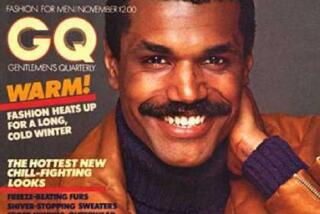Donald Reilly, 72; New Yorker Cartoonist for 40 Years
- Share via
Donald Reilly, a cartoonist whose slightly menacing sense of humor dotted the pages of the New Yorker magazine for more than 40 years, died Sunday. He was 72.
Reilly, who is also credited with more than a dozen covers for the magazine, died of cancer at Norwalk Hospital in Norwalk, Conn., his daughter, Patricia Reilly, said.
He was known for a drawing style that was rich in props and atmospherics. He sketched quickly to achieve a feeling of spontaneity, and his cartoon captions were mini social commentaries that were based on his voracious reading and his talent as a good listener.
“The essence of the so-called ‘gag’ cartoon is its simplicity and directness,” Reilly said in an interview in the 1975 book “The Art in Cartooning.” “If successful, it communicates instantly, producing an immediate reaction.
“The idea is the thing, and the drawing must put it across quickly and effectively. The faster the thought is communicated the greater the impact.”
In Reilly’s cartoons the grown-ups are well-dressed urbanites whose young sons never take off their baseball caps and whose preteen daughters dress like stylish Eskimos with spindle legs.
He had a few favorite topics he often returned to, particularly the office, the sexes and the family. Executives obsessed with business deals were fodder for his humor. In one cartoon, three chief executives wearing angel wings stand on clouds and compare notes. “Oh, it’s great here all right,” one says, “but I sort of feel uncomfortable in a place with no budget at all.”
Married couples’ pet peeves inspired many Reilly cartoons, including one that shows a man and woman dressed in city clothes and driving on a deserted country road. She looks worried. He blurts out, “Because my genetic programming prevents me from stopping to ask directions -- that’s why!”
The father of three children and three stepchildren, Reilly often poked fun at parenting. In one cartoon a mother and her little boy stand in front of a dinosaur skeleton at the museum. “They got extinct because they didn’t listen to their mommies,” the mother warns.
He was not a sourball, said Lee Lorenz, a former art editor of the New Yorker and a longtime friend of Reilly, although some subjects raised his ire. Psychotherapy, for instance. In one cartoon, a therapist presses a button, the couch tilts up and the patient is dumped through a trap door in the floor.
“Don was a stylist,” Lorenz said. “His art was fun. There was a seamless blend of caption and idea.”
Typical of professional cartoonists of his generation, Reilly was a trained artist and thought that such training was essential for anyone in his profession.
“Younger cartoonists are essentially writers,” Lorenz said of today’s generation. “It’s all about ideas. They keep the drawing minimal, which is probably a good thing.”
Born Nov. 11, 1933, in Scranton, Pa., Reilly started drawing cartoons at 5 after he saw the animated film “Gulliver’s Travels.” He later recalled spending months drawing scenes from the movie.
In high school he took trumpet lessons and listened to jazz on the radio. It was the start of a sideline career as a jazz musician. He played at weddings and parties.
At Muhlenberg College in Allentown, Pa., he majored in English but also went back to cartooning. His work was published in the college newspaper where he was an editor.
After graduation he served in the Navy, finished military service in 1957 and enrolled as an art student at Cooper Union in New York City, where he earned a certificate in fine arts.
Early in his career he contributed cartoons to Look, Colliers, Punch and other magazines. He joined the New Yorker in 1964.
His cover illustrations for the magazine, with strong, dark outlines and warm color washes, resembled stained-glass windows, Lorenz said. Some were sight gags, including one that shows a pianist’s hand on the keyboard. His fingernails are gold.
Reilly, who lived in Wilton, Conn., was married twice. His first marriage ended in divorce. He is survived by his second wife, Kathleen Collins Reilly; his sister, Helene Fagan; three children from his first marriage; three stepchildren; and eight grandchildren.
More to Read
The biggest entertainment stories
Get our big stories about Hollywood, film, television, music, arts, culture and more right in your inbox as soon as they publish.
You may occasionally receive promotional content from the Los Angeles Times.










